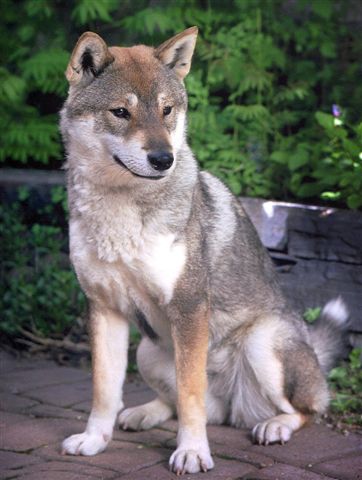- Shikoku (dog)
Infobox Dogbreed
altname = Japanese Wolfdog, Kochi-ken, Mikawa Inu

country =Japan
fcigroup = 5
fcinum = 319
fcisection = 5
fcistd = http://www.google.com/search?q=cache:Y-t11l5tMnIJ:www.fci.be/uploaded_files/319gb99_en.doc+&hl=en&gl=ca&ct=clnk&cd=1
ckcgroup=Miscellaneous
ckcstd=
ckcmisc=yes
ukcgroup = Northern Breeds
ukcstd = http://www.ukcdogs.com/WebSite.nsf/Breeds/Shikoku
name = Shikoku The Shikoku ( 四国犬; alternative names: Kochi-ken, Mikawa Inu) is a native, primitiveJapan ese breed ofdog fromShikoku island that is similar to aShiba Inu . The Shikoku is not a recognized breed of theAmerican Kennel Club , but it is recognized by the Japanese Kennel Club, an organization recognized by AKC as an official foreign registry [http://www.petpublishing.com/dogken/breeds/shibainu.shtml] (AKC recognizes theShiba Inu , however). The Shikoku is also in theCanadian Kennel Club miscellaneous class and the United Kennel Club,awaiting full recognition. In 1937 the Japanese Crown recognized the Shikoku dog as a living "natural monument" of Japan [http://www.fci.be/uploaded_files/319gb99_en.doc] .Comparison to other Japanese breeds
The Shikoku is one of the native Japanese breeds intermediate in size between the large
Akita Inu and the smallShiba Inu ; all are within theSpitz family of dogs. The Shikoku was bred mainly for hunting deer and boar in the mountainous districts of Kochi Prefecture. It is sometimes called "Kochi-ken" and, along with the Kai dog, referred to as a deerhound.A study of the 1930s carried out by the Japanese cynologist [Haruo Isogai was a dog breeder who worked up a classification system for Japanese dogs based on appearance, as a nationalist response to the adoption by dog enthusiasts in Japan of European breeds in the 1930s. ( [http://www.worldwidebase.com/doggybase/de_kai.shtml] in Dutch) ( [http://www.zaras-traumwelten.de/thread.php?threadid=643] in German) There is no evidence that he had any relevant scientific training or even that he ever called himself a "cynologist".] Haruo Isogai classified all native Japanese dog breeds into three categories: large-, medium-, and small-sized. The Shikoku belongs to the Shika-inus, the medium-sized dogs. Other medium-sized dogs are the
Kai Ken , the Ainu and theKishu Inu . They are all very similar with overlapping colors and only minor differences in size and morphology.Characteristics and Temperament
It is cautious and brave with good judgment. It is also loyal to its master. It has sharper features than most Japanese dogs and is sometimes allowed to chase wild
boar so it will maintain its nature.Shikoku dogs are tough and sufficiently agile to run through a mountainous region. They are the ideal companion for active outdoor people. They are very energetic and active outside but they are calm and quiet indoors. The Shikoku is a very intelligent dog and a quick learner. They are not as stubborn and independent as the other native Japanese breeds, but still it is not a dog for every person. The Shikoku stands 17-21 inches (43-53cm) high and comes in sesame (white, red, black) or solid red. The body confirmation is typically of the spitz-type: the square body, the wedge-shaped head, the prick triangular ears, and feathered curled tail.
The Shikoku dog is somewhat unique in its appearance. It looks similar to an
Alaskan Husky dog physically, but differs in its size and color. The Shikoku Inu, when healthy, ranges from thirty-five to fifty-five pounds (male) and from seventeen to twenty-one pounds (female). This dog would be considered medium sized. The Shikoku Inu can be seen in a variety of colors, sometimes even mixed ones. These colors consist usually of a light brown, a light red-brown, or a light black-brown. In addition, there is a cream colored coat that tends to be very rare. In all of these colors there is usually a mixture of white found around the underside of the body, near the eyes, snout, and legs. The Shikoku tends to shed its coat at least one to two times a year. The dog has a fairly thick coat with pointed ears and a curved tail. Since this breed is so rare, any of the variety of color combinations would be considered a prize.Varieties
Three varieties of this breed have been identified: the Awa, the Hongawa, and the Hata all named after the area where they were bred within the Shikoku prefecture. The Hongawa breeding area being the most remote and least accessible, the dogs of the Hongawa line maintained the highest degree of purity and was considered the best type.
Health
With a life span of ten to twelve years, Shikoku need to be properly taken care of, like every other dog. Health is a big part of the Shikoku's life, because dogs such as these suffer from common sicknesses when not given the right things to eat, or not getting enough time outside . Common sicknesses in shikoku happen in the bones, joints, ears, muscles, and nerves. Disease also occurs from things such as trauma and infection. Other more serious issues relate to heart, lung, digestive, and urinary problems.
hikoku in Popular Culture
The savage Koga Dogs of the Japanese
manga series are thought to be Shikoku, although they are portrayed as havingmohawk -like shocks of fur on their heads. Kurojaki is thescythe -wielding leader of these dogs, and his son Tesshin is an important hero in the sequel seriesGinga Legend Weed . Both series are byYoshihiro Takahashi .Notes
References
* [http://www.dog-names.org.uk/shikoku.htm Dog-names info on Shikoku]
* [http://www.hund.ch/fotos/fshikoku1.htm First Shikoku Dog]
* [http://www.shikokudog.com/ Shikoku Dog Website ]
* [http://japanesedogs.bulldoginformation.com/shikoku-inu.html Shikoku Inu @ The Canine Information Library]
* [http://japanesedogs.bulldoginformation.com/shikoku-inu.html]
* [http://www.shikokudog.org/ Shikoku Dog Forum]
* [http://www.akashima.bc.ca/ Akashima Kennels - breeder of the Shikoku Inu]
Wikimedia Foundation. 2010.
